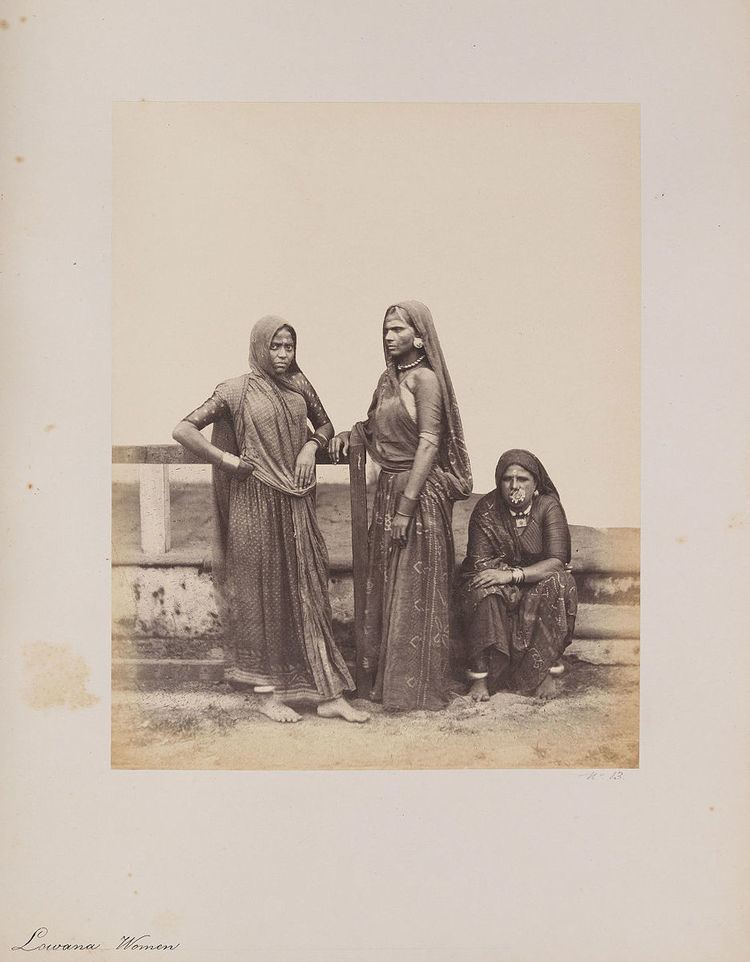 | ||
The Lohana, also referred to as Luvana and Luhana, are an Indian caste, traditionally largely occupied as merchants.
Contents
The Lohanas are divided into three separate cultural groups as a result of centuries apart in different regions. Thus there are significant differences between the culture, language, professions and societies of Sindhi Lohanas (those who migrated from Sind after partition of India), Kutchi Lohanas (those living or having ancestry in Kutch), and those of Gujarati Lohanas (those living or having ancestry in Saurashtra).
History
Although considered to be Vaishya in the Hindu ritual ranking system known as varna, the Lohanas favour a mythical origin as members of the Kshatriya varna.
In the 7th century, there was a Buddhist ruler named Agham Lohana ruled a part of Sindh and was Governor of Brahmanabad and contemporary of Chach of Alor. Agham Lohana is referred to in Chach Nama and the city of Agham Kot is said to be named after him. Even the sea around was known as Lohana Darya (Darya means Sea). Chach of Alor killed Agham Lohana in battle of Brahmanand and married his widow and also married his niece to Agham's son Sirhind. Further, Chach is said to have laid restrictions of Lohana and Jat tribes from wearing headgear and carrying weapons. He further placed upon the Jat and Lohana restrictions such as:
Conversion to Islam and migration of Hindu Lohanas
The community's oral history says that the decline of their kingdom began after the death of Veer Dada Jashraj the decline of Lohana . It also says that their name derives from the city of Lohargadh (/Lohanpur/Lohkot) in Multan, from which they migrated in the 13th century AD after the establishment of the Muslim rule there.
Pir Sadardin converted many of them to the Shia Ismaili Nizari sect of Islam in 14th Century AD. As Lohanas were worshipers of Shakti, in order to convert them Ismaili missionaries made certain modifications in their doctrines to convert them. They are known as Khojas or Khawaja.
In 1422, Jam Rai Dan was tribal leader in Sindh during the Samma Dynasty, he was converted to Islam by Sayad Eusuf-ud-Din and he adopted a new name Makrab Khan. At that time a person named Mankeji was head of eighty-four nukhs of Lohanas, who was in favor in court of that Samma king. He was persuaded by ruler and the Qadri to convert to Islam. However, not all Lohanas were ready to convert from Hinduism. But 700 Lohana families comprising some 6178 persons converted to Islam at the hands of one in Thatta Sindh. These are now known as Memons.
Sindh which had fallen under Muslim rule of Muhammad bin Qasim after defeat of Dahir and the Hindus were increasingly pressurized to either convert to Islam or face persecution and were living in constant fear. It was around this time, that Uderolal who is revered as Jhulelal ( by Sindhis ) or Dariyalal (by Gujaratis and Kutchis ) and Zinda Pir ( by Muslims ) who was born in to Ratanchand (Ratnarai) Thakkur and Devki, a Hindu Lohana family of Nasarpur in Sindh. He took upon the mantle of Lohana and Hindu leadershi. Today Uderolal is revered as Jhulelal, the patron saint of Sindhis and also considered to be as Pir and revered as Jinda Pir, as such, both Hindus and Muslims visit the site of his Samadhi. The Lohanas after Dariyalal took samadhi for almost two centuries Hindus and Lohanas remained fearless but later again due to their Hindu identity being discriminated and increasingly threatened in Sindh and they began to migrate mainly towards Kutch and Saurashtra
Sindhi Lohanas have since been divided into several groups, among which are:
Rituals
Lohanas largely follow Hindu rituals and worship Rama, Shiva, Surya, Randal, Ambika, Shakti and Shrinathji apart from their clan deities like Veer Dada Jashraj, Harkor, Sindhvi Shree Sikotar Mata and Dariyalal.
Diaspora
Thousands of Lohanas left India between 1880 - 1920 and migrated to British colonies in the African Great Lakes region of Uganda, Kenya and Tanganyika, where there was already a bustling Gujarati Muslims merchant class diaspora. Later following Idi Amin's expulsion of South Asians in 1972, most of them moved to the United Kingdom, and to a lesser extent to United States, and Canada.
